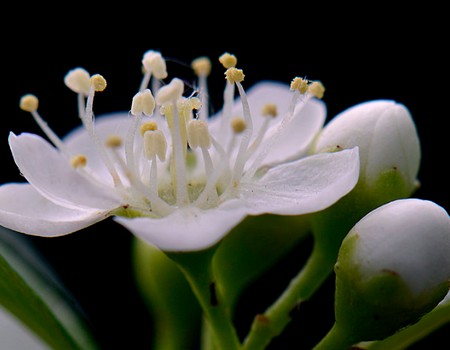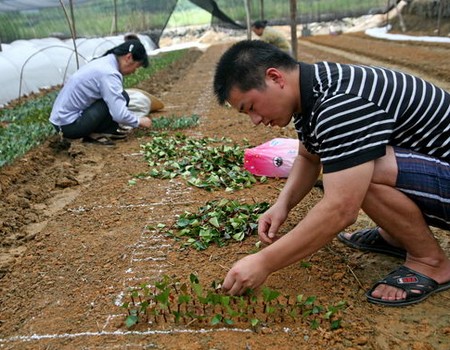Propagation and cultivation techniques of heather flower
The heather flower is produced in the south of Qinling Mountains in China. It is a subtropical tree species, positive and shade-tolerant. Heather is suitable for cultivation in places with fertile, moist, deep soil and good drainage. It is also resistant to drought and barren and can grow in stone crevices. Not resistant to moisture, cold, in Shandong and other areas can survive the winter. The sprouts are strong, resistant to pruning and shaping, and grow slowly. Today, I would like to briefly introduce the propagation and cultivation techniques of heather.

Photinia is an excellent ornamental tree species in landscaping, its reproduction to sow, because of many fruits, so a wide range of provenances, smooth branches. After the seeds were harvested in November, they were soaked in clean water, fermented and rubbed to remove the seed coat, rinsed to get the seeds for sand storage, and sown the following year. It can also be propagated by cuttings and striping.
Nursery selection:
The soil of heather planting land is loose, fertile, slightly acidic to neutral, convenient for irrigation and good drainage. Before planting, 3000 kg of rotten barnyard manure and 50 kg of superphosphate were applied per mu, the depth of soil ploughing was more than 25 cm, and pesticides were applied to control underground pests. After ploughing, the soil will be leveled, and the drainage ditch will be opened to make a seedbed with a bed width of about 1 meter.
Selection of seedlings:
When buying seedlings, we should choose suppliers who have a good reputation and can provide high-quality after-sales service, so as to ensure the purity of varieties and reduce production risks. The seedlings provided are all high-quality container seedlings, with good product consistency and well-developed roots, especially with substrate transplanting without root injury, the survival rate is almost 100%, and grows rapidly after transplanting.
Transplanting of seedlings:
The transplanting time of seedlings is generally from March to April in spring and from October to November in autumn, which should be determined according to the local climatic conditions. The planting spacing should be determined according to the time of staying in the nursery and the cultivation goal. If it is planned to sell according to the cultivation of annual shrubs, the suitable row spacing is 35x35 cm or 40x40 cm, about 3000 plants per mu.
When transplanting heather seedlings, it is necessary to carefully remove the packaging or nutrition bowl to ensure the integrity of the root soil ball and dig holes at a fixed point. Pile the root with fine soil, and stretch the root system, gently compacting it. After planting, the root water should be watered in time to maintain the wetness of the soil so as to create a good growth environment for the seedlings.
Management of cultivation:
In the slow seedling period after planting, special attention should be paid to water management. in case of continuous sunny days, water should be watered 3-4 days after transplanting, and then every 10 days or so; in case of continuous rainy days, it should be drained in time. After about 15 days, the seedlings can be fertilized after the slow seedling stage. Urea is applied every half a month in spring, with a dosage of about 5 kg / mu.
Compound fertilizer is applied every half a month in summer and autumn, the amount of compound fertilizer is 5 kg / mu, and the amount of secondary mature organic fertilizer is 1500 kg / mu in winter. Fertilization should be based on the principle of frequent application of thin fertilizer, do not use too much at one time, so as not to hurt the roots and burn seedlings, and usually remove weeds and loosen the soil in time to prevent soil consolidation, which is disadvantageous to growth.
Pest control:
Heather had strong resistance and no destructive diseases and insect pests were found. However, Botrytis cinerea, leaf spot or shell insects may occur if the nursery is not properly managed or the nursery environment is poor. Botrytis cinerea can be prevented by spraying 50% carbendazim 1000 times solution, and during the onset period, 50% Dysen zinc solution can be used to prevent and control the disease. Leaf spot disease can be controlled with 50% carbendazim 300 to 400 times or topirazine 300 Mel 400 times. Scale insects can be sprayed with 200x dimethoate emulsion or 800x to 1000 fold spray.
Time: 2019-06-11 Click:
- Prev

Propagation methods of Paeonia lactiflora
Peony can also be regarded as a kind of precious flower, which is similar to peony, but different. Peony is called the king of flowers, peony is called the phase of flowers, and the cultivation of peony is more common than peony. Paeonia lactiflora is a perennial perennial flower, which is native to northern China. At present, there are wild species in Qinling and Dabie Mountains.
- Next

Cutting propagation technique of heather flower
Photinia has round crown, green leaves, purple leaves in early spring, white flowers at the end of spring and red fruits in autumn. It is a famous tree species for courtyard greening, resistant to smoke, dust and poisonous gases, and has the function of sound insulation. There are two main methods for the reproduction of Photinia chinensis: sowing and cutting.
Related
- Fuxing push coffee new agricultural production and marketing class: lack of small-scale processing plants
- Jujube rice field leisure farm deep ploughing Yilan for five years to create a space for organic food and play
- Nongyu Farm-A trial of organic papaya for brave women with advanced technology
- Four points for attention in the prevention and control of diseases and insect pests of edible fungi
- How to add nutrient solution to Edible Fungi
- Is there any good way to control edible fungus mites?
- Open Inoculation Technology of Edible Fungi
- Is there any clever way to use fertilizer for edible fungus in winter?
- What agents are used to kill the pathogens of edible fungi in the mushroom shed?
- Rapid drying of Edible Fungi

